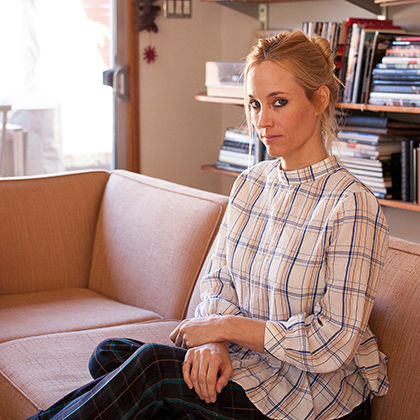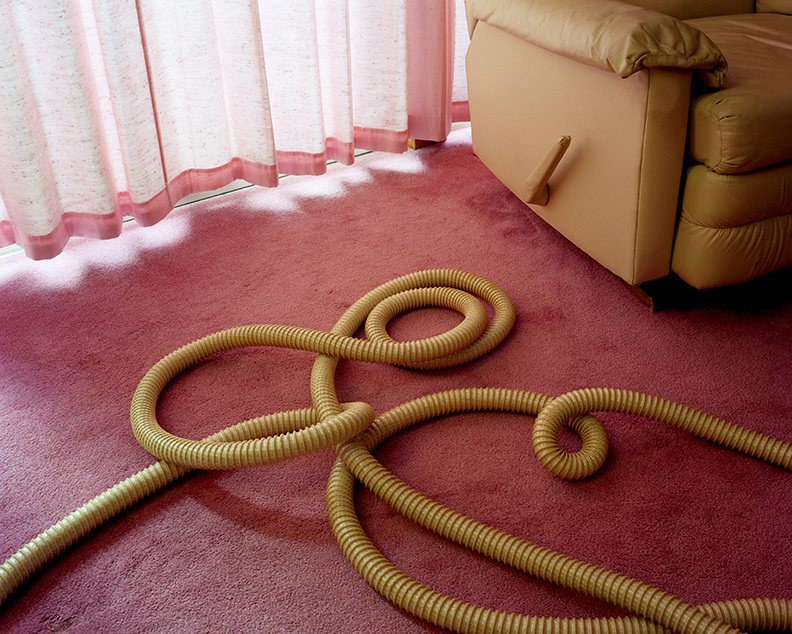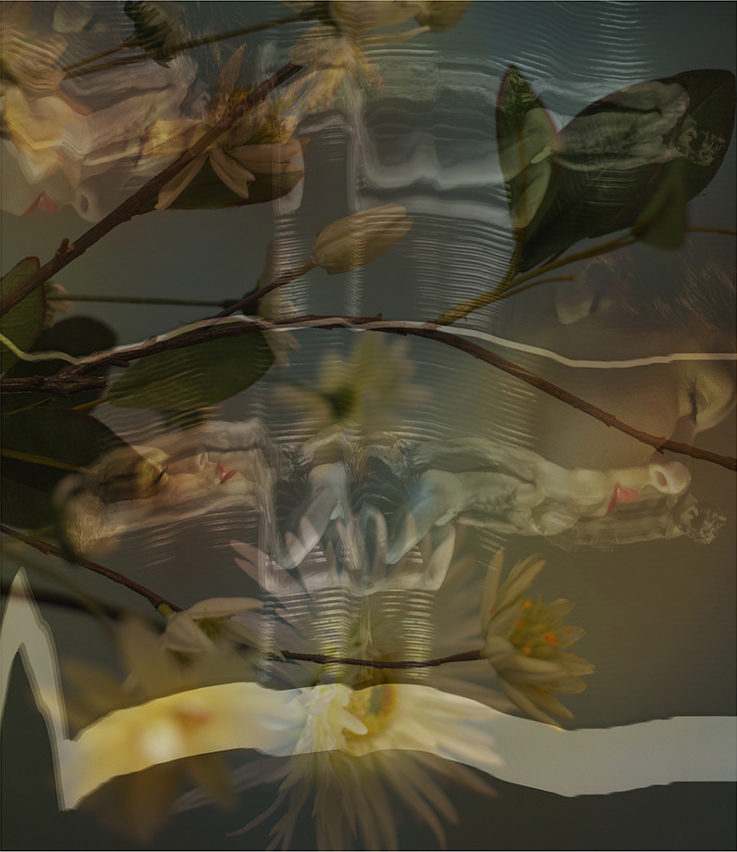Artist portrait by James Jenkins

Artist portrait by James Jenkins
Melanie Willhide
Los Angeles based artist
Interview by James Jenkins
JAMES JENKINS: It’s Wednesday, December 16, 2015, and I am interviewing Melanie Willhide in her home in Altadena, California. Will you tell me about your visual work?
MELANIE WILLHIDE: I’m really interested in how photographs cultivate artificial intimacy. I am interested in how photographs play into how people perform their desires. Formally I am interested in the fragmentation of the surface of an image and on occasion the subject pictured. I have also been fairly dedicated to diminishing or obscuring the photograph to talk about its artifice in my work.

Poison Wings from the series Palindrome, 20 x 24 in. ©2014
JENKINS: Describe a favorite photograph or piece of art that you’ve made.
WILLHIDE: There are two and they were both made really early on in my career. The first image is of my grandfather, and you can see the influence of Yale graduate school in the way it was made. It is a 4×5, shot horizontally, with a slightly wide lens and the aperture is stopped down to capture tons of depth of field. The image is of him showing me how he used to dance with my grandmother. He had this incredible mid-century modern house and the interior is all wood. In the background, there’s a wooden closet that runs the full length of the wall and on the floor a pink carpet. We are witnessing this moment where he dances with his eyes closed, and you see him experiencing this joyous memory. When I got the film back, the closet behind him was open, just a little and there was a white top hat, up in the closet, about 4 or 5 feet directly above his head. I hadn’t noticed it at all. This is not surprising as I tend to be very neglectful of the edges of my photographs. I’m always photo-shopping stuff out, or cropping the image.
The other photograph was made in the same room. It’s just of a vacuum cleaner hose. In the image, it was just piled up in the middle of a pink carpet in a perfectly manicured room. Behind it there are closed pink curtains so it feels very insular, and it just looks like intestines. The image represented a really formative thing about my need to turn things inside out. I realized how photographs can be absolutely referential to something that is not even in the picture plane, nothing to do with what you’re actually making a photograph of.

Swallow from the series Mimic, 20×24 in.©2001
JENKINS: Can we talk specifically now about your creative process? What inspires you to be creative?
WILLHIDE: I feel my practice is most similar to a poet. Most of my favorite contemporary poets are word thieves, stealing words from situations that they experience. I imagine them sitting on the subway, and hearing something said and they write it down and it becomes the opening line to the next poem. Some people will go and research, and they go to tons of exhibits and they go see art openings. I don’t really force myself to look at art. I force myself more to listen, similar to poets and I observe how people interact with each other. I think my work as a result tends to be fairly psychological. I guess if I’m talking about collecting ideas for my practice, it’s very understated, the way in which I collect information.
“I don’t really force myself to look at art. I force myself more to listen, similar to poets, and I observe how people interact with each other. I think my work as a result tends to be fairly psychological.”
JENKINS: Do you feel that when you’re in this creative mindset, or space, that you are hyper-absorbent?
WILLHIDE: Something will reveal itself, and I can’t take my eyes off it, or I can’t stop eavesdropping. I just have to make a note of what I have seen or heard. It could be very, very basic. For example, I may notice how the light shines through a random piece of plastic I might see on the floor. I think it looks beautiful. A very banal observation, that I note and maybe much later translates into how I light an image. I often beat myself up for not being that person that is very social in the art scene, attending every show and researching other artists. For me the creative mindset is simple. It exists in the moment and usually, I do not force it.
JENKINS: It sounds like you might create or process organically. How do you then take that information and structure it? In other words, how do you go back to those notations, or those moments that you’ve thought about, or observed, and then make them into something else?
WILLHIDE: With my observations of lighting, once I’ve developed a concept for a project, I start to pepper my observations of lighting to offer a unique look to the work. That’s a very difficult question. I have to think about it.
JENKINS: When you’re producing art, do you feel like you have to step into a studio or a particular space, or do you simply reserve the day for making art?
WILLHIDE: When I’m teaching, I have a full day, one full day a week devoted to making art, and then I work at night, really, really late at night, but it’s not a structured schedule. I will fold clothes, and then I’ll go and work in Photoshop, or I’ll scan something, and then I’ll wash the floor. It’s just woven into my day. I don’t go to a studio. I have rented studios, and they become storage spaces. The place where I make the work has to be in the house, just my daily life, and what people would do at home, taking naps on the couch, deciding that you can watch television while you’re eating lunch.
JENKINS: Do you think that creativity is hard work?
WILLHIDE: Yes. For me, it’s extremely difficult. It’s mile 13 in the marathon, most of the time, almost 90% of the time.
“I have a kind of penchant for exploring nostalgia, and looking at perception. A lot of people talk about my work as it relates to memory, but I actually think I’m much more interested in how people perceive what they’re looking at.”
JENKINS: When you are creative do you have a sense of dread in the beginning?
WILLHIDE: I’m absolutely brutal with myself at the very beginning. I have to police myself, in order to get myself into it and I become super regimented. However, there’s a beautiful moment, that’s maybe three quarters of the way through, where you’re just loving your new baby, and you’re really vested in what you’re doing. There is a real give and take, but for the most part, it’s difficult. You put expectations on yourself, maybe that other people aren’t aware of or don’t understand. I’m always telling myself, “Well, my collectors will want this and it needs to be done in this amount of time,” and it’s just part of my practice to really flog myself. Within that art form, there’s a real serious regimen and there’s only a couple of ways to enter that art form, and they’re not easy, but to get to the love of creating, there’s a lot of work.
JENKINS: How do you access your ideas? Since your work is driven by concept how do you access those concepts?
WILLHIDE: They’re usually through personal experience and observation. There have been rare occasions where it will come directly from somebody else’s work. I’ve had a few other artists in my life, where they’ll make something, and it kind of sends me into this moment of inspiration, but usually, it’s based in my own observations and experiences.
JENKINS: How do you recognize a good idea?
WILLHIDE: For me a good idea is an idea that engages with culture in an unconventional way, or a new way, which is getting more and more difficult, that has an understanding of history, and art history, and it maybe has a little bit of a sense of humor, a little bit of humanity in it. When I’m looking at art, those are sort of the criteria that I’m judging work by.
JENKINS: Is there any role of chance in your creative practice?
WILLHIDE: It’s forced its way in. The last two major projects were based off of catastrophes in my life. All my stuff burned in the desert while I was moving to California. Someone broke into my home and stole two years worth of work, and then I got that computer back that housed the work and I had this element and experience of all the work being digitally destroyed. I was not very open to chance at all prior to that, but when you have things like this happen, it just opens you up to chance. Like the top hat over my grandfather’s head, it makes you take yourself a little less seriously. If you take yourself so seriously, I find the work can’t move. It becomes really rigid, and you can feel that when you see work, by certain artists, where there’s such a formula to it, so yes I welcome chance.

Eye of the Day from the series Henbane for Honeybun, 30×26 in. ©2014
JENKINS: Are there recurring themes in your work?
WILLHIDE: Yes. I would say I have a kind of penchant for exploring nostalgia and looking at perception. A lot of people talk about my work as it relates to memory, but I actually think I’m much more interested in how people perceive what they’re looking at. I would say, the imposition of culture, and how that embeds us in time, is a pretty common theme, so I’m trying to think of other things. I’d say, romantic events, or trauma, which is kind of related to nostalgia, have definitely been a recurring theme in my work since the very beginning.

T and V-Mesa Elks from the series to Adrian Rodriquez with love, 30×28 in. ©2011
JENKINS: Let’s talk about how you begin a project or a new image within a project.
WILLHIDE: I am working on a new series, and it’s still so new, it started out, kind of as a generalized observation of something that caught my eye. In this particular circumstance, I have become the executor of my uncle’s will, and he’s a collector of paintings. These paintings, throughout the course of my lifetime, have begun to just disintegrate. When I went back this earlier last year, they were in a fairly heightened state of disintegration, and disarray, and I thought, there’s something here. There’s something so beautiful about oil paintings that are cracking. It’s almost better than when they were first freshly painted, because there is a level of wear and tear, as if saying “I’ve been in the world”. When I started this project, and with every project, it’s always this one moment where I think, “Oh, that’s interesting.”
It’s the cracks in the surface of a painting, I don’t over-intellectualize it at all, and I just go, and I will shoot 100 sheets of film, or 300 digital images, not judging myself at all, really staving off that voice that says, “This is stupid. This is going nowhere. This is not interesting. Who gives a shit about cracks in paintings?” I just really allow myself to engage in it purely. I call it the button gut chakra, it’s like button gut artwork. It just feels good, and it looks good, and it satiates me, and that’s it. It’s not up here yet. At the beginning, it’s always like that and It’s funny because as I became more educated, the judgment gets bigger and bigger and bigger.
Something works, and there’s no history beating on it, there’s no art magazine beating on it, there’s no this person that did it, or this guy that did it. In my circumstance, it’s always men. Men cut pictures out of magazines, or Robert Heineken did this, or that. That part of my creative practice is really nice, because it’s just pure love. It’s just like, I love to look at this thing, and it can just be the sequins on the surface of a dress. It can be so topical and artificial. Then from there, you sort of work it into another arena, which for me, the second part, is much harder, when you start to put all that stuff on top of the creative process like history, and culture.
“We are all ascetics, and in making art we are taking a vow of poverty in hope of enlightenment, it’s just part of being an artist.
JENKINS: So in the second phase of the work where you start to consider things. What exactly do you consider?
WILLHIDE: I start to consider the newness of the subject, if it’s actually new, if it’s reinvention, what is it conversing with, in terms of the image culture. It’s not limited just to visual art. It could be film, it could be the E Entertainment channel, it could be articles in the newspaper, or it could be a poet that I recently read, so it definitely becomes, what context is this going to exist within, and does it deserve to be there. Can it talk back, or is it going to be the quiet one at the dinner party? That is sort of phase two.
JENKINS: My final question is what advice would you give to developing artists?
WILLHIDE: The United States gives out 100,000 MFA graduate degrees a year, and there are something like 600 mid-tier, and upper tier galleries. You do the math. I’m not telling one not to peruse art, but just be open to the way in which it can be contextualized, because there’s a lot of ways art can play out. You can be a great painter, and end up making fabric, or be a great glass blower, and come up with a line for a corporate or mainstream furniture company. I think you should not be so Bauhaus and not focus on just one media and be open to a lot of experiences. I don’t think art schools really prepare students very well for that, they are kind of stuck in the past, master of one thing.
More of Melanie Willhide’s work can be viewed at: melaniewillhide.com
Article edit by Mark Daybell

THE PRACTICE OF CREATIVITY
©2015-2019 All rights reserved
